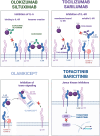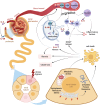Targeting inerleukin-6 for renoprotection
- PMID: 39723211
- PMCID: PMC11668664
- DOI: 10.3389/fimmu.2024.1502299
Targeting inerleukin-6 for renoprotection
Abstract
Sterile inflammation has been increasingly recognized as a hallmark of non-infectious kidney diseases. Induction of pro-inflammatory cytokines in injured kidney tissue promotes infiltration of immune cells serving to clear cell debris and facilitate tissue repair. However, excessive or prolonged inflammatory response has been associated with immune-mediated tissue damage, nephron loss, and development of renal fibrosis. Interleukin 6 (IL-6) is a cytokine with pleiotropic effects including a major role in inflammation. IL-6 signals either via membrane-bound (classic signaling) or soluble receptor forms (trans-signaling) thus affecting distinct cell types and eliciting various metabolic, cytoprotective, or pro-inflammatory reactions. Antibodies neutralizing IL-6 or its receptor have been developed for therapy of autoimmune and chronic non-renal inflammatory diseases. Small molecule inhibitors of Janus kinases acting downstream of the IL-6 receptor, as well as recombinant soluble glycoprotein 130 variants suppressing the IL-6 trans-signaling add to the available therapeutic options. Animal data and accumulating clinical experience strongly suggest that suppression of IL-6 signaling pathways bears therapeutic potential in acute and chronic kidney diseases. The present work analyses the renoprotective potential of clinically relevant IL-6 signaling inhibitors in acute kidney injury, chronic kidney disease, and kidney transplantation with focus on current achievements and future prospects.
Keywords: IL-6; acute kidney injury; anti-cytokine therapy; chronic kidney disease; inflammation; kidney transplantation; trans-signaling.
Copyright © 2024 Gubernatorova, Samsonov, Drutskaya, Lebedeva, Bukhanova, Materenchuk and Mutig.
Conflict of interest statement
MS and DB are employed by R-Pharm JSC. The remaining authors declare that the research was conducted in the absence of any commercial or financial relationships that could be construed as a potential conflict of interest.
Figures



Similar articles
-
Targeting interleukin-1 signaling for renoprotection.Front Immunol. 2025 May 23;16:1591197. doi: 10.3389/fimmu.2025.1591197. eCollection 2025. Front Immunol. 2025. PMID: 40486517 Free PMC article. Review.
-
Interleukin-6: A Masterplayer in the Cytokine Network.Oncology. 2020;98(3):131-137. doi: 10.1159/000505099. Epub 2020 Jan 20. Oncology. 2020. PMID: 31958792 Review.
-
Interleukin-6 contributes to the increase in fibroblast growth factor 23 expression in acute and chronic kidney disease.Kidney Int. 2018 Aug;94(2):315-325. doi: 10.1016/j.kint.2018.02.026. Epub 2018 May 31. Kidney Int. 2018. PMID: 29861060
-
Macrophages in kidney injury, inflammation, and fibrosis.Physiology (Bethesda). 2015 May;30(3):183-94. doi: 10.1152/physiol.00046.2014. Physiology (Bethesda). 2015. PMID: 25933819 Review.
-
Interleukin-6: An Important Mediator of Allograft Injury.Transplantation. 2020 Dec;104(12):2497-2506. doi: 10.1097/TP.0000000000003249. Transplantation. 2020. PMID: 32235253 Review.
Cited by
-
Innate immune cells in acute and chronic kidney disease.Nat Rev Nephrol. 2025 Jul;21(7):464-482. doi: 10.1038/s41581-025-00958-x. Epub 2025 Apr 22. Nat Rev Nephrol. 2025. PMID: 40263532 Review.
References
Publication types
MeSH terms
Substances
LinkOut - more resources
Full Text Sources

